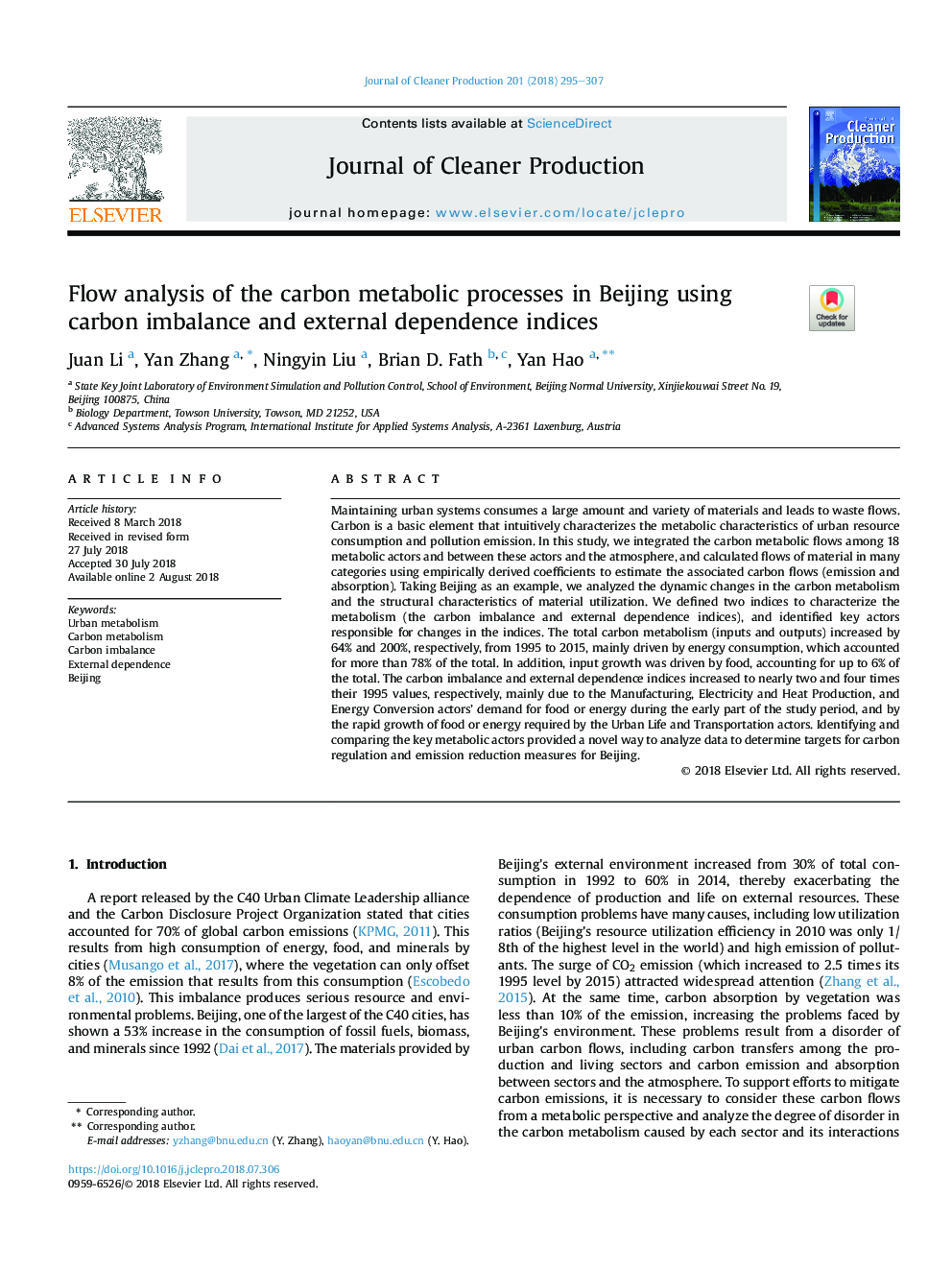| کد مقاله | کد نشریه | سال انتشار | مقاله انگلیسی | نسخه تمام متن |
|---|---|---|---|---|
| 8092717 | 1522051 | 2018 | 13 صفحه PDF | دانلود رایگان |
عنوان انگلیسی مقاله ISI
Flow analysis of the carbon metabolic processes in Beijing using carbon imbalance and external dependence indices
ترجمه فارسی عنوان
تجزیه و تحلیل جریان فرآیندهای متابولیسم کربن در پکن با استفاده از عدم تعادل کربن و شاخص های وابستگی خارجی
دانلود مقاله + سفارش ترجمه
دانلود مقاله ISI انگلیسی
رایگان برای ایرانیان
کلمات کلیدی
متابولیسم شهری، متابولیسم کربن، عدم تعادل کربن، وابستگی خارجی، پکن،
ترجمه چکیده
حفظ سیستم های شهری، مقدار زیادی از مواد مختلف را مصرف می کند و منجر به جریان های زباله می شود. کربن یک عنصر اساسی است که به طور مستقیم ویژگی های متابولیک مصرف منابع شهری و انتشار آلودگی را مشخص می کند. در این مطالعه، جریانهای متابولیک کربن را در میان 18 بازیگر متابولیک و بین این بازیگران و جو زمین، و جریانهای محاسبه شده مواد در بسیاری از گروهها با استفاده از ضرایب مشتق شده مشتق شده برای تخمین جریانهای کربن مرتبط (انتشار و جذب)، یکپارچه کرده ایم. به عنوان مثال، با توجه به پکن، ما تغییرات پویا در متابولیسم کربن و ویژگی های ساختاری استفاده از مواد را تحلیل کردیم. ما دو شاخص برای مشخص کردن متابولیسم (عدم تعادل کربن و شاخص های وابستگی خارجی) را تعریف کردیم و عوامل کلیدی مسئول تغییرات شاخص ها را شناسایی کردیم. متابولیسم کل کربن (ورودی ها و خروجی ها) به ترتیب از سال 1995 تا 2015 به ترتیب 64٪ و 200٪ افزایش یافته است که عمدتا به دلیل مصرف انرژی است که بیش از 78٪ از کل هزینه را به خود اختصاص می دهد. علاوه بر این، رشد ورودی به وسیله غذا رانده شد، که تا 6 درصد کل آن را تشکیل می دهد. عدم تعادل کربن و شاخص وابستگی خارجی به تقریبا دو و چهار برابر مقادیر 1995 به ترتیب به طور عمده به دلیل تولید، تولید برق و حرارت و تقاضای بازیگران انرژی تبدیل شده در مواد غذایی یا انرژی در اوایل دوره مطالعه افزایش یافت، و با رشد سریع مواد غذایی یا انرژی مورد نیاز بازیگران زندگی شهری و حمل و نقل. شناسایی و مقایسه بازیگران متابولیک کلیدی روش جدیدی برای تجزیه و تحلیل داده ها برای تعیین اهداف تنظیم کربن و اقدامات کاهش انتشار برای پکن است.
موضوعات مرتبط
مهندسی و علوم پایه
مهندسی انرژی
انرژی های تجدید پذیر، توسعه پایدار و محیط زیست
چکیده انگلیسی
Maintaining urban systems consumes a large amount and variety of materials and leads to waste flows. Carbon is a basic element that intuitively characterizes the metabolic characteristics of urban resource consumption and pollution emission. In this study, we integrated the carbon metabolic flows among 18 metabolic actors and between these actors and the atmosphere, and calculated flows of material in many categories using empirically derived coefficients to estimate the associated carbon flows (emission and absorption). Taking Beijing as an example, we analyzed the dynamic changes in the carbon metabolism and the structural characteristics of material utilization. We defined two indices to characterize the metabolism (the carbon imbalance and external dependence indices), and identified key actors responsible for changes in the indices. The total carbon metabolism (inputs and outputs) increased by 64% and 200%, respectively, from 1995 to 2015, mainly driven by energy consumption, which accounted for more than 78% of the total. In addition, input growth was driven by food, accounting for up to 6% of the total. The carbon imbalance and external dependence indices increased to nearly two and four times their 1995 values, respectively, mainly due to the Manufacturing, Electricity and Heat Production, and Energy Conversion actors' demand for food or energy during the early part of the study period, and by the rapid growth of food or energy required by the Urban Life and Transportation actors. Identifying and comparing the key metabolic actors provided a novel way to analyze data to determine targets for carbon regulation and emission reduction measures for Beijing.
ناشر
Database: Elsevier - ScienceDirect (ساینس دایرکت)
Journal: Journal of Cleaner Production - Volume 201, 10 November 2018, Pages 295-307
Journal: Journal of Cleaner Production - Volume 201, 10 November 2018, Pages 295-307
نویسندگان
Juan Li, Yan Zhang, Ningyin Liu, Brian D. Fath, Yan Hao,
